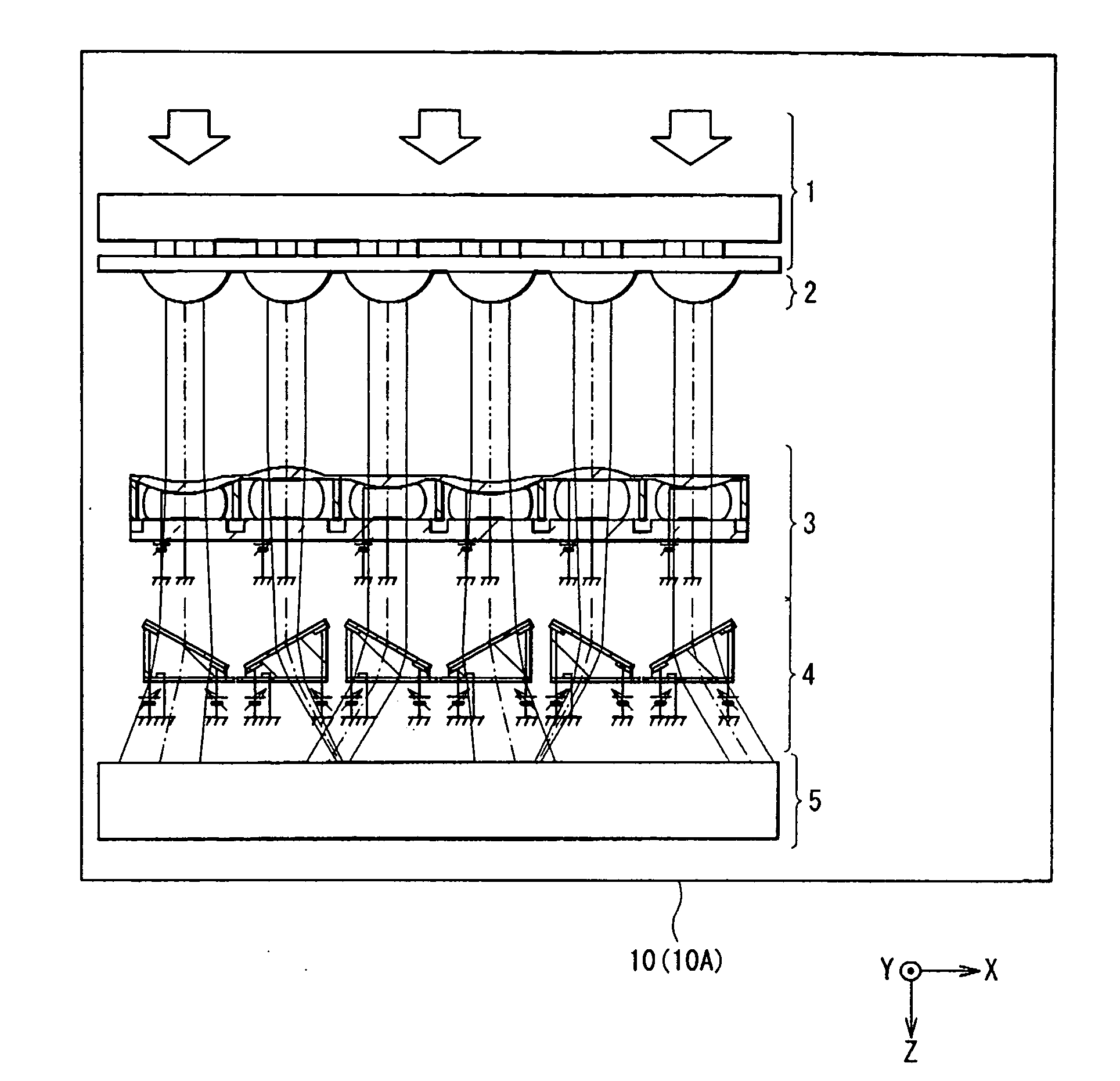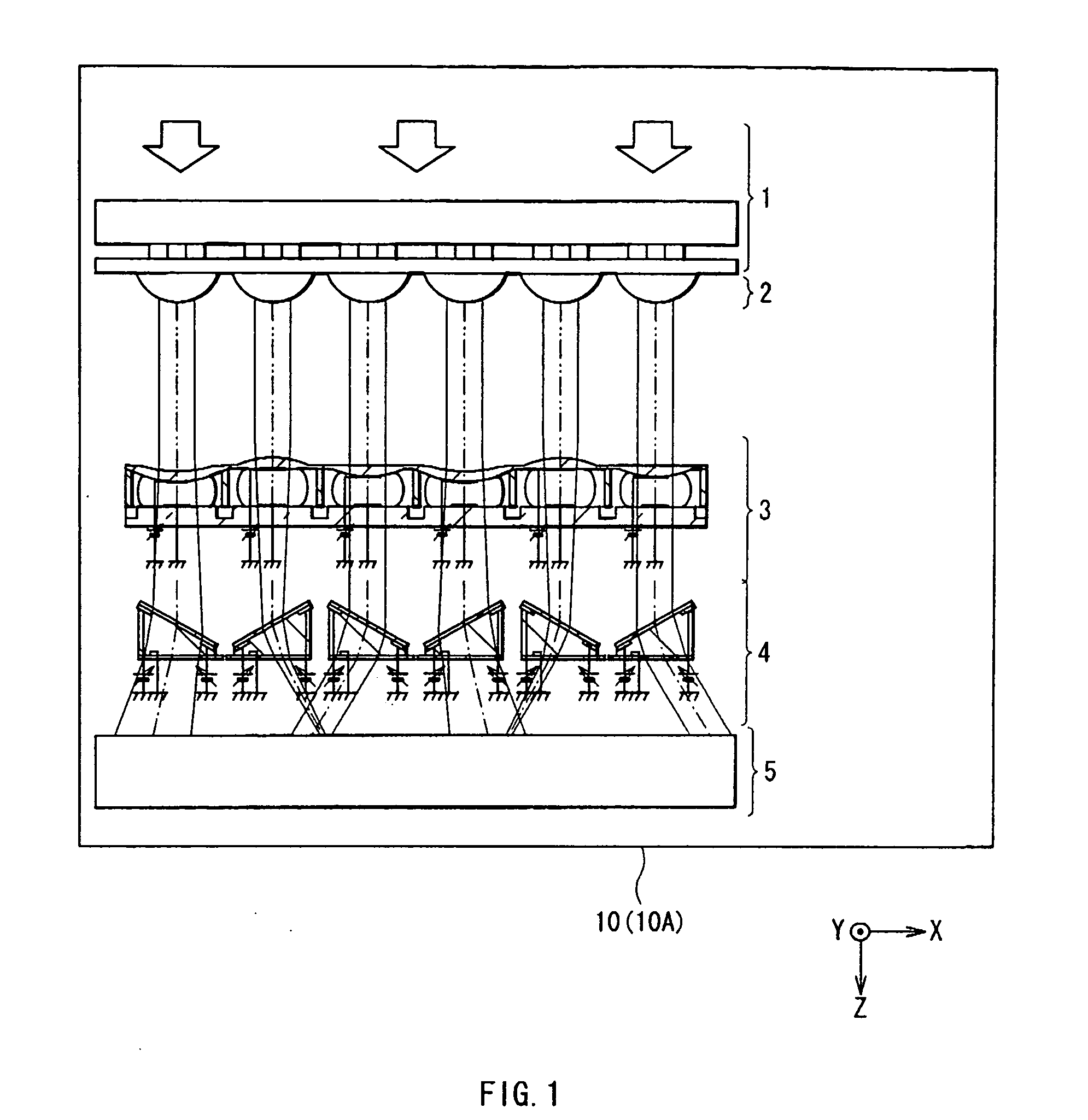Three-dimensional display
a three-dimensional display and display technology, applied in the field of three-dimensional display, can solve the problems of large amount of information, extremely large spatial frequency of three-dimensional spatial information, and difficulty in displaying a stereoscopic image in real-time holograms
- Summary
- Abstract
- Description
- Claims
- Application Information
AI Technical Summary
Benefits of technology
Problems solved by technology
Method used
Image
Examples
first embodiment
[0048] At first, a three-dimensional display 10 (to distinguish from a second embodiment which will be described later, hereinafter referred to as three-dimensional display 10A) according to a first embodiment of the invention will be described below. FIG. 1 shows a structural example of the three-dimensional display 10A. FIG. 1 is a schematic view in a horizontal plane.
[0049] The three-dimensional display 10A includes a two-dimensional display section 1 having a plurality of pixels, a collimation section 2 converting the wavefront of display image light emitted from each pixel into a parallel light flux, a lens array 3 converting the wavefront of the parallel light flux converted in the collimation section 2 into a wavefront having a curvature which allows the display image light to focus upon a focal point where an optical path length from an observation point to the focal point is equal to an optical path length from the observation point to a virtual object point, a horizontal ...
second embodiment
[0090] Next, a three-dimensional display 10B according to a second embodiment of the invention will be described below. In the first embodiment, the variable focal-length lens is used as a wavefront conversion means. In the embodiment, a variable focal-length mirror is used.
[0091]FIG. 18 is a conceptual diagram for describing the whole structure of the three-dimensional display 10B. As shown in FIG. 18, the three-dimensional display 10B includes the two-dimensional display section 1, the collimation section 2, a mirror array 6 as a wavefront conversion means and a deflecting mirror 4B as a deflection means in order.
[0092] The mirror array 6 includes a plurality of variable focal-length mirrors 61 as shown in FIG. 19. FIG. 19 shows a schematic sectional view of the mirror array 6. As in the case of the variable focal-length lens 31, the variable focal-length mirror 61 is an optical device capable of freely changing its focal length by deforming a part of the variable focal-length m...
example
[0102] Next, an example of the invention will be described below.
[0103] In the example, a variable focal-length lens 31E with a structure shown in FIG. 20 according to the invention was formed, and the characteristics of the variable focal-length lens 31E were evaluated.
[0104] As shown in FIG. 20, in the variable focal-length lens 31E as the example, a transparent deformation member 33E having a thickness gradually reduced from a central position CL and a column 34E were integrally molded. The transparent deformation member 33E had a circular plan shape having its center in the central position CL. Moreover, a space between a transparent electrode layer 36E and a transparent electrode layer 37E which were arranged in a central region in a thickness direction was 0.01 mm. The transparent electrode layers 36E and 37E were made of ITO, and were circular thin films with a diameter of 0.8 mm. A filling layer 35E was made of silicone. The filling layer 35E was formed through coating a d...
PUM
 Login to View More
Login to View More Abstract
Description
Claims
Application Information
 Login to View More
Login to View More - R&D
- Intellectual Property
- Life Sciences
- Materials
- Tech Scout
- Unparalleled Data Quality
- Higher Quality Content
- 60% Fewer Hallucinations
Browse by: Latest US Patents, China's latest patents, Technical Efficacy Thesaurus, Application Domain, Technology Topic, Popular Technical Reports.
© 2025 PatSnap. All rights reserved.Legal|Privacy policy|Modern Slavery Act Transparency Statement|Sitemap|About US| Contact US: help@patsnap.com



